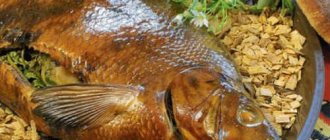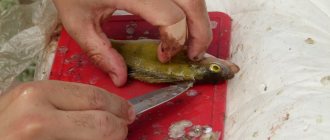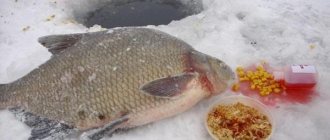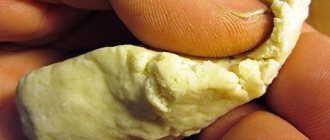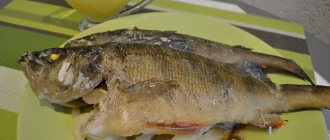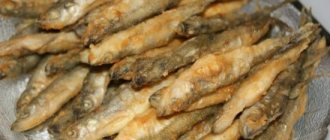How to instantly clean scales from a perch without dust and dirt: 5 quick ways
Everyone knows that cleaning a perch is a rather thankless task.
Small and tightly packed scales are tempting to fly out from under the knife and litter the entire kitchen. Those who don’t know and are faced with cleaning scales from a perch for the first time should obviously be prepared not only for the problematic cleaning of the fish, but also for the subsequent cleaning of the room (in particular the kitchen) from scattered scales here and there.
To prevent this from happening, to quickly clean small scales from perch at home, to keep the kitchen clean, I advise you to take a closer look at popular folk methods.
Clean in a minute
This option is considered optimal. It will help the housewife to easily remove scales from sea bass. However, this method has one significant drawback: the scales are removed along with the skin. Since most fish lovers prefer to eat fried fish with crispy skin, this cleaning method is not suitable for them. Thus, you can complete cleaning in just 60 seconds.
You will need to do the following:
- Make a cut along the back of the fish on both sides, focusing on the dorsal fin.
- Pulling the fin out of the back is not difficult at all.
- After removing it, remove the skin from the product - it will come off along with the scales. In this case, cleaning will not be necessary. The skin is separated from both sides.
- Cut the ridge near the head. To do this, the head of the perch is cut off, but not entirely.
- Remove the fish from the head, giblets and skin. The carcass can be considered ready to create a delicious dish. It looks like a simple fillet. The tail can also be cut off.
Ways to quickly and without dirt remove scales from a perch at home
Don’t cause trouble for yourself and your loved ones, adopt all these three useful methods. You and your household will be very happy!
I will briefly describe each option for cleaning perch.
Method 1 - remove the scales, but don’t touch the skin
The main tool in this case will be real boiling water. In general, the fish needs to be scalded with boiling water:
- Pour water over the perch from the kettle over the sink.
- Boil water in a saucepan and plunge the striped fish into the boiling water.
Using this method, scales are easily and quickly removed without problems, without any pain. But the skin of the perch - the most delicious thing in fish - remains.
Method 2 - no scales, but no skin either
In this situation, we won’t even have a skin left. And how delicious it is fried and rosy!
This way you will get perch fillets. One of the fastest ways to descale a perch at home. I was able to clean one fish in less than 1 minute.
1. Along the entire length of the back of the perch, cuts are made on both sides of the upper fin.
2. Take out the sharp fin (it comes off easily) and simply remove the skin along with the scales.
3. Next, we cut the ridge in the area of the head. We insert the thumb of the left hand along the ridge inside, and with the right hand we separate the head along with the giblets - it turns out in the form of a stocking.
4. Finish line - separate the tail. All!
Method 3 - if the perch is from the freezer
If you have an excellent catch and brought in more perch than normal (although I never set the bar), then you will save some of it in the freezer for the future.
This is the third method that is suitable for frozen fish.
1. First of all, remove the top and bottom, similar to when peeling a cucumber with a vegetable peeler.
2. Then cut off the tail. And now it's skinning time.
3. Afterwards, cut off the head and clean the entrails of the perch.
The good thing about frozen fish is that it is always in a solid state and is easier and easier to clean.
Method 4 - sprinkle heaps of salt on the perch - the old-fashioned way
1. Take a fresh catch of perch and roll it generously in salt.
2. Leave it for half a day (or overnight) in this form.
3. The salt will do its job and then all that remains is to lightly pry the skin with a knife and it will give in easily.
Again, only fillet, without the delicious crispy skin. But they cleaned it up.
Method 5 - extreme - car wash
And this method lives in the vastness of our homeland.
There is a high-pressure apparatus for washing a car with a gun and nozzles for a certain type of jet.
So “Kulibins” set up “Kärcher” (one of the leaders in sales of such sinks). They attach the fish by the tail and boldly, mercilessly “sweep away” all the scales with a stream.
The scales are flying merrily all over the yard. But the fish is cleaned and the goal is achieved!
Choose your favorite method of cleaning river perch, clean and cook your favorite dish!
Follow my channel - it will be even more interesting!
NHNCH (No tail, no scales) to everyone!
Subscribe to my fishing tricks, give it a thumbs up and tell your friends on social networks!
How to bake whole bream in foil in the oven
According to avid fishermen, the most delicious fish will be obtained by baking bream with scales, without cutting, whole. In order not to lose a drop of fat and to maintain the juiciness of the meat, the best way is to cook it in foil. Then the dish will exceed all your expectations.
When baking in this way, the fish skin is easily removed from the bottom up. The scales do not fly off and do not interfere with eating. All the fat remains in the fish, making it juicy.
You will need:
- Large bream – 1.5-2 kg.
- Lemon.
- Black pepper.
- Salt.
- Garlic cloves – 2-3 pcs.
- Thyme, rosemary, any spices for fish - all seasonings of your choice.
Step-by-step preparation:
- Make a small cut on the belly of the bream. Reach in with your fingers and gently but firmly pull out the insides. Do not tear abruptly, so as not to disrupt the integrity of the gallbladder. If this happens, lengthen the incision and quickly and conscientiously rinse the inside of the abdomen. In the video offered at the end of the article, you can see how to remove the entrails through the back of the fish.
- Cut the carcass along the entire length diagonally (3-4 cuts).
- Squeeze the juice from the lemon, pepper, add other seasonings as desired, salt, garlic pulp. Stir the mixture. Rub the carcass, trying to get into the cuts, and put a little inside the fish.
- Place foil on a baking sheet and place the fish. If the tail of a large fish does not fit in length, trim it with scissors.
- Wrap the carcass in foil, leaving no holes. Place in the oven.
- Baking temperature – 180-190 o C. Baking time – hour. Take it out, unfold the sheet and check readiness. If necessary, if the bream weighs about two kilograms, return it back and hold for another 10 minutes. Transfer to a wide dish and begin the belly feast.
Using the list of ingredients from the previous recipe, cook the fish whole, but without scales, by cleaning the bream carcass. The only addition to the list is sunflower oil.
How to cook:
- Remove scales from the carcass. Gut the fish by making a cut in the belly. Remove the fins and head. Rinse and place on a napkin to absorb excess moisture.
- Rub the bream with pepper and salt all over the carcass.
- Cut the lemon into slices along with the zest. Finely chop the garlic cloves. Start the belly.
- Brush the fish with oil.
- Place on a sheet of foil and arrange sprigs of thyme and rosemary on top.
- Wrap the fish tightly and place in the oven. Bake at 180 o C for 30-40 minutes.
We suggest you read: How to quickly and easily learn how to clean carp
What you need to clean fish
In order for cleaning to take place without consequences in the form of chaos and scales scattered everywhere, you should prepare everything you need in advance:
- a wooden or plastic board that is not prone to absorbing odor and is easy to clean;
- a well-sharpened knife or scissors;
- a bowl of cold water or a sink for washing dishes;
- rubber gloves (necessary if you have abrasions and wounds on your hands);
- disposable kitchen towels or napkins.
Methods for cleaning bream from scales
There are a number of ways to quickly and easily scale fish, and almost all of them are used by chefs in professional kitchens. Below are a few of the most popular. By the way, the fresher the carcass, the easier it will be to clean it - it is recommended to carry out the procedure immediately after catching.
How to clean with a knife
For this method, you need to prepare a sharp knife, a cutting board, a plastic bag and the fish itself.
Cleaning occurs in the following sequence:
- Rinse the fish from mucus. Cut out the dorsal fin, and on both sides make shallow cuts throughout the body.
- Pull the fin from the tail to the head, get rid of the pectoral fins.
- Place a plastic bag on a cutting board and place the fish in it.
- Starting from the tail, with quick movements using a knife, remove the scales against its growth in small sections, folding them side by side.
- When one side is ready, flip the bream over to the other and follow the same steps.
- After complete cleaning, rinse the bream under cold water.
Using boiling water
This option is considered the simplest, but can be done in two ways.
First:
- Wear kitchen gloves on your hands to avoid getting cut or scratched during the process.
- To boil water.
- Place the bream in the dishwashing sink.
- Pour boiling water over both sides.
- Wait about 30 seconds, then use a knife to remove all the scales.
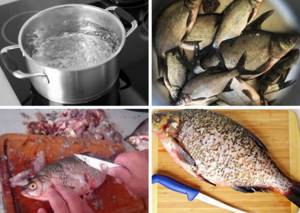
The second method involves the following sequence:
- Turn on the burner to maximum heat and place a pan of hot water on it.
- Bring the contents to a boil and place the bream in the pan for a few seconds.
- Pull it out, put it on a board and, with a well-sharpened knife, remove the scales with light movements.
Quick cleaning method with skinning
Cleaning is completed in a minute, which can rightfully be considered the main trump card, but there is also a minus - the scales are removed with the skin. This may be a deciding factor for people who prefer to fry their fish and enjoy crispy skin.
You need to do the following:
- Using the dorsal fin as a guide, make one cut on each side along the back.
- With a slight movement, pull out the fin.
- Then remove the skin - after the previous step it will come off without any problems along with the scales.
- Repeat all steps on the other side.
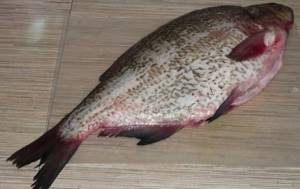
Features of cleaning frozen fish
Sometimes it happens that you need to clean a frozen product. After the described steps, you can easily pick up the edge of the skin near the head and pull - it will come off in one layer.
This can be done at home, just follow the following sequence:
- It is necessary to cut out the upper part of the back from head to tail of frozen bream. The piece should be thin and cut very carefully. The movements are performed as when peeling potatoes.
- Cut off the thin layer of the belly.
- Next, get rid of the tail.
Application of boiling water
To clean the perch properly, you can use hot water. The method is especially popular with people who like crispy skin. For many gourmets, this part of the fish is the most delicious and appetizing.
Cutting perch can be done in two ways:
- The fish is placed in the dishwashing sink and then doused with boiling water.
- Place the product in a boiling pan of water for a few seconds, then clean it with a sharp knife or a special tool for cleaning fish.
After removing the fish from boiling water, be sure to cut off all the fins. It is best to use scissors for this purpose. Removing the fins will prevent cuts on your hands when cleaning the product. Cleaning the perch can be done with a special fish knife or an ordinary kitchen knife. The scales steamed with boiling water are removed much easier and practically do not fly apart. After removing the skin, you need to gut the fish and rip open its belly.
If you plan to fry river perch with its head, it is worth removing the gills. You can cut off the entire head.
How to gut it properly
After you have gotten rid of the scales using any of the above methods, you need to properly gut the fish. The procedure takes up to 10 minutes and is completely uncomplicated. You need to take a sharp knife and carefully make an incision from the anal fin to the head, slightly open it with your hands. All organs are removed through the resulting hole. If there is caviar, it must be carefully separated from the intestine.
Depending on whether the head is needed during the cooking process, it can be separated from the body or only the gills can be removed from it. Next, the gutted fish is thoroughly washed under running water, and every thin film is removed from the internal cavity.
Another option for getting rid of entrails is using a spoon and knife. The washed fish is placed on a cutting board and a longitudinal cut is made from head to tail. Using a spoon, carefully remove the insides without damaging the gallbladder.
For greater convenience, you can take two toothpicks and place them so that they independently hold the walls of the abdomen. At this stage, the film that covers the spine is cut and the remaining blood is removed. You need to rinse the fish thoroughly several times. Next, the gills are removed or the head is completely cut off, and the product is ready for further manipulation.
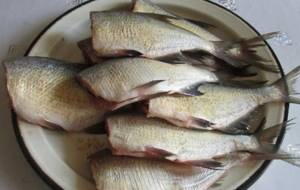
Bream should be added to the diet, as it is an excellent prevention of stroke, promotes weight loss and skin rejuvenation. Guided by the above rules and recommendations, you can properly and quickly clean this fish at home.
Express option in 6 minutes
There is an express method on how to properly clean bream, which allows you to start cooking your catch in 6 minutes. It consists of the following steps:
- washing off mucus under running water;
- removing scales;
- trimming fins with scissors;
- ripping of the peritoneum;
- removal of entrails;
- washing;
- cutting off the head.
Then you can do anything with bream, from simple salting to cooking real delicacies.
You can ask your question to our author:
How to clean fish correctly
What unites fishermen and housewives? They equally dislike cleaning fish. Mucus, scales flying around, prickly fins - all this is annoying. The process can take a long time if you do not follow a number of simple rules. How to clean fish correctly and quickly? More on this later.
How to clean fish scales quickly and correctly
Since there is little pleasure in cleaning fish, many try to get the job done as quickly as possible. However, in a hurry, people make a bunch of mistakes that only delay the process. One of the first mistakes is using the wrong tool.
Advice!
In nature, a special grater is used to clean fish with hard scales. But in its absence, you can make such a tool yourself. To do this, several tin beer or lemonade caps are nailed to a wooden board. You can also make something like a grater out of a tin can by punching holes in the bottom with a nail so that notches are formed.
So, how to clean fish? To clean a carcass you will need: • Tool (knife, grater), • Cutting board, • Towel or rag. Before cleaning the fish, it is recommended to wash it thoroughly to remove mucus under cold water. Then dry the scales by blotting them with newspaper or a towel. If the fish has hard scales, it is recommended to dip the fish in boiling water for a second or scald it; it will become more pliable for processing. It is important not to overexpose the fish when processing it thermally.
Methods for quickly cleaning bream from scales
- In order to quickly remove scales from bream, the fish can be placed in the freezer for a few minutes. There is no need to wait until the fish freezes; the main thing is that the surface of the bream, or rather the skin with scales, is slightly frozen. The bream is removed from the freezer and immediately placed comfortably on a cutting board. Taking a knife in one hand and holding the fish with the other, first in the head area and then in the tail area, quickly remove the scales with confident hand movements. When cleaning scales, you need to make clear, confident movements against the growth of scales. When cleaning, the knife should be pressed down lightly so that it has enough strength to tear off each scale. When cleaning this way, you need to remove the scales in small portions and immediately put them away on a separate plate (in the trash). After removing the scales from one side of the bream, turn the carcass over and continue cleaning the other side. The scaled bream is washed well under running water, thus washing off the remaining scales. Carefully examine the carcass again: if there are scales left on it in some areas, remove them too, and then rinse again.
- There are methods for cleaning fresh bream, which has almost just been taken out of the water. This method is most often used by fishermen in natural conditions, right where bream is caught for direct preparation of fresh fish soup. The bream is conveniently placed on a flat surface (it can be a log or an ordinary board) and they begin to remove the scales with a knife. This kind of cleaning is good for summer time; you can go outside and calmly clean the bream. However, it is more suitable for those living in rural areas. City dwellers will have to clean the kitchen and at the same time try to prevent the scales from flying off to the sides, otherwise it will take a long time to collect them later.
- If you suspect that you will not be able to clean the scales of the bream carefully, and then you will have to wash the kitchen for a long time, then use a regular garbage bag when removing the scales. The bream along with the cutting board is placed in a bag and the scales are cleaned as if inside the bag. Of course, such cleaning will also not be 100% perfect, but in any case, less scales will scatter around.
- To remove scales from bream, it is not necessary to use a knife. These can be special tools designed specifically for cleaning fish or a grater with large cells.
- Well, for the laziest, when cleaning bream from scales, you can use the simplest and, frankly, the most convenient and “clean” method - removing the scales from the bream carcass along with the skin. To do this, a shallow cut is made in the head area with a knife along the entire circumference, and then the skin is pulled off like a sock.
How to clean fish from scales?
It’s nice to deal with fish without scales in the kitchen, but what to do if you come across a variety with a solid “chain mail”?
In some cases, cooking with the scales or the scales themselves is allowed, because it contains vitamin PP and chromium, which are important for health. It is impossible to eat, but jelly prepared on this basis has a wonderful taste.
- When it comes to cleaning fish, they do it simultaneously with gutting.
- Sharp fins must be cut off to avoid injury.
How to clean fish: advice from experienced fishermen
An inexperienced person will need a lot of effort to scrape off the scales. They will fly in different directions and stick to kitchen surfaces. But experienced fishermen have already come up with a lot of options that make it easier to prepare fish for cooking. Here are some options on how to clean fish and leave a minimum of debris:
- Using a serrated kitchen knife, the blunt side of a regular knife, and a fork, process the fish, placed in a plastic bag. It is important to carry out manipulations so that the package does not tear;
- In a sink or deep bowl filled with water, the scales are cleaned using a thin-edged teaspoon. You need to squeeze the fish head with your fingers. The method is good for small fish;
- large scales are handled with a sharp fillet knife. Its blade is inserted from the side of the tail between the scales and the skin. The gradual removal of such a stocking can be lengthy, but guarantees the cleanliness of the kitchen;
- Skin removal with a stocking is carried out starting from the head. After making 2 cuts, grabbing the edge of the skin with pliers, clean the fish. It is recommended to do this on paper or a bag in the kitchen sink;
- the scales slide off evenly after scalding the fish with boiling water on both sides. You can put it in boiling water for a few seconds. The method is good even for very tightly fitting scales. Its disadvantage is that useful substances are lost, although the processing does not particularly affect the taste;
- Using special tools for cleaning fish speeds up the process by 2-3 times. Designs with a small container are especially convenient. The scales are neatly collected there, without clogging the surrounding space;
- The fish with its scales is boiled, removing the skin and separating the bones afterwards.
By choosing one of the listed methods, there is no doubt that the fish will be cleaned of scales efficiently, and the kitchen will delight you with its cleanliness.
Sources:
https://zen.yandex.com/media/rybalov/kak-momentalno-pochistit-okunia-ot-cheshui-bez-pyli-i-griazi-5-bystryh-sposoba-5c38070b5d92d200abadf6d2 https://fermer.blog/bok /rybovodstvo/ryby/lesch/17038-kak-chistit-lescha.html https://www.nur.kz/1679506-kak-chistit-rybu-pravilno.html https://ladym.ru/publ/recepty_kulinarii/kak_pochistit_leshha_ot_cheshui /3-1-0-8073 https://www.wday.ru/dom-eda/soh/chistit-ryibu-chtobyi-ne-letela-cheshuya-nehitryie-sposobyi/

